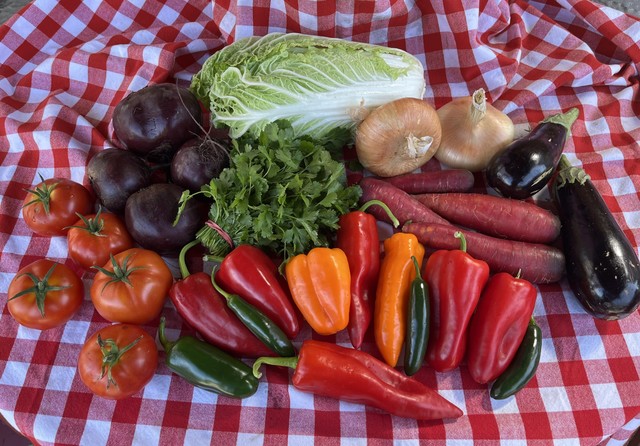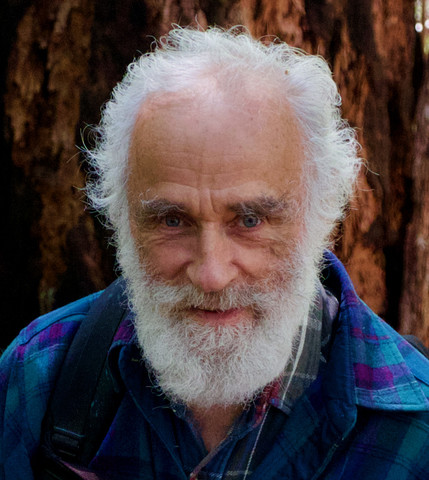- Beets
- Napa Cabbage - light in texture, mild in flavor. Makes a great raw slaw or salad, or cooks up in infinite ways. Try this "Melting Napa Cabbage" recipe!
- Purple Carrots
- Sweet Peppers, LOTS of sweet peppers!
- Tomatoes
- Cipollini Onions - pungent when raw, incredibly sweet when caramelized.
- Serrano and Jalapeño Peppers
On Rotation:
- Eggplant
- Cilantro
A Man and a River: Grieving them Both
Many, many of us are preoccupied by and grieving the fire on Elk River right now. For those of you who don't know the Elk, it's an incredible place on earth: a steep watershed full of old growth forest and cold crystalline water, home to wild salmon and marbled murrelets. If you were familiar with spectacular Opal Creek in the Cascades (before it burned catastrophically a couple years ago), the Elk is the Opal Creek of the southcoast. For many of us, it's a pilgrimage kind of place - where you go for renewal and reconnection to the wild. It's the place where I retreat to recharge, the place that fills me back up with life force, the place that I'm always melancholy to leave after a weekend of hot rocks and cold turquoise water and ripe thimbleberries. I spent large chunks of my childhood up the Elk River - camping for days at favorite swimming holes, and even rafting sections of the river during high water in the winter (imagine champagne bubble flood waters - clear, not muddy like the rest of our coastal streams in winter). We've swum/crawled/scrambled every mile of the canyon from Butler Bar to the fish hatchery, exploring like wet-suit clad river otters. It is a place beloved, and currently engulfed in flames.
The Anvil fire started a couple weeks ago with the rumble of midnight thunder. I remember waking up to the sound of it, then the flashes of lightning, and thinking "Please let that be to the west, over the ocean. Not inland." My very next thought lying there in bed was, "Jim. Oh no. Jim is gone. Who will protect the Elk?"
Jim Rogers, lifelong guardian of the Elk, had died just a week earlier due to complications related to Parkinsons disease. I had just learned of his passing, feeling the loss of him and my dad as a dual blow (they were friends, and two peas in a conservation pod who worked together to gain protection for the Elk). Sometimes described as a “logger-turned-environmentalist,” Jim started his career as a young forester working for the timber industry. In his timber survey work, he recognized what a special place the Elk was and turned his energy towards conservation, at a time when most of the Coast Range was being leveled by clearcut logging. From his little cabin on the Elk, to Salem, to Washington, D.C., he circled tirelessly to organize political support for protecting the watershed. Over his lifetime, that unflagging dedication to Elk River led to the designation of two wilderness areas—the Grassy Knob (1984) and Copper Salmon (2009), and to designation of the Elk River (1988) and its tributaries (2019) as "Wild and Scenic." All told, he protected more than 30,000 acres of old-growth forest and over 75 miles of wild and scenic river (if ever there was an example of the oft-quoted Margaret Mead quote, Jim was at the center of it: "Never doubt that a small group of thoughtful, committed, citizens can change the world. Indeed, it is the only thing that ever has.”).
I laid there listening to the rumble-flash of the sky, hoping Jim's legacy was not in harm's reach, trying not to worry myself out of a good night's sleep.
But by mid-morning there were reports of four spot fires up the Elk. Fortunately we had a stretch of high humidity and light winds on the heels of the Labor Day rain, but that all changed last week as temps rose and winds picked up. The fire has grown to almost 15,000 acres, many residents on the lower Elk have been evacuated, air quality is abysmal to the south, and it's considered 0% contained. As grim as all of that feels, the forecast has me hanging onto hope. The growing promise of rain next week can't come soon enough (even though in the farming realm we are maximizing every last shred of daylight to get potatoes, winter squash, and dry beans out of the field as quickly as possible while we have dry weather).
I have spent quite a bit of time in new wildfire burns the past few years on my horsepacking trips: the Trinity Alps, Jefferson Wilderness, the Gifford-Pinchot, the Wallowas. Fire scars are a ubiquitous - and ever-dominant - element in the landscape nowadays with climate change. Every time I enter a recent burn on horseback there is an emotional reckoning - so much sadness for the cool, dark, beautiful forest that is no longer there, but also amazement as life resurges out of the char and ash. Last year in Jefferson, two years after the huge fires that almost reached Portland and scorched Opal Creek to cinder, we saw fir seedlings 6 inches tall, wildflowers, early-succession shrubs - the thinnest scrim of green against a black backdrop of burn. You had to look, but it was there. The forest that returns - in Jefferson Wilderness, and on the Elk - will probably look different than the one it replaces, especially as conditions get hotter and drier. And it will never be a mature, towering old growth forest in my lifetime again. But maybe for my kids, my grandkids. I would like to think that they might head up the Elk on a summer day 50 years from now and see a river canyon filled with green, shading that incredible clear water. And before they leap off the high rock at Jumpoff Joe's, give thanks to Jim Rogers for the legacy he left to us all.
To learn more about Jim's life, there is a great Oregon Field Guide episode about him from about 10 years ago: https://watch.opb.org/video/oregon-field-guide-jim-rogers/
To read his full obituary, go to https://www.westrumfuneralservice.com/obituary/James-Rogers
A celebration of Jim's life event will be held on Saturday, October 28 at 2pm in Port Orford, location TBD.
Pray for rain. Lots of it.


